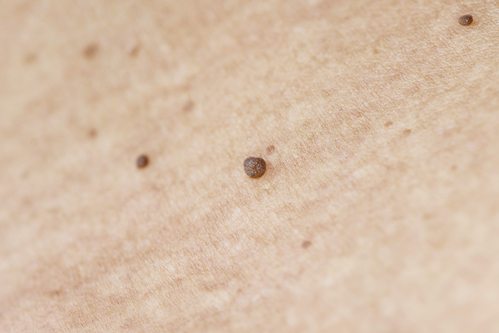Skin tags have a variety of “technical” names. For example, if you prefer, you can refer to a skin tag as a cutaneous papilloma, an acrochordon, a fibroepithelial polyp, a fibroma molluscum, a cutaneous tag, or a fibroma pendulum. According to the National Institutes of Health, you can find skin tags on approximately 46% of the population. By the age of 70, almost 60% of people will have developed skin tags. So what are skin tags? And how can you get rid of them?
What Are Skin Tags?
Skin tags are small growths that contain fibers, nerve cells, ducts, and fat cells covered by a layer of skin. They are usually very small and flat initially. Since they are normally the same color as flesh or just slightly browner, the first sign of a skin tag may be feeling a pinhead bump that you had not noticed before. As skin tags grow, they often develop a stalk that lifts them above the skin’s surface.
Where Do Skin Tags Grow?
Skin tags can grow on any part of the body, but they usually occur in places where the skin rubs against clothing or where there is skin-to-skin contact. The most common locations for skin tags to develop are under the breasts, in the armpits, on the eyelids, in the groin area, on the neck, or on the upper chest.
What Causes Skin Tags?
Because of the locations where skin tags are typically found, it is believed that irritation leads to blood vessels and collagen becoming trapped inside a thicker layer of skin. This is why skin tags frequently develop in folds and creases of the skin, as well as areas where clothing fits tightly around the neck or torso. However, various studies have also concluded that there are a number of risk factors for developing skin tags, including all of the following:
- People with diabetes as well as those with excess insulin in the blood are more prone to developing skin tags.
- An imbalance in a person’s levels of progesterone and estrogen may increase their risk of skin tags.
- Those who are obese are at greater risk of developing skin tags since they have more skin creases and folds.
- Pregnant women may develop skin tags due to hormonal changes.
- Individuals with human papilloma virus are at great risk for developing skin tags.
- Insulin resistance has been shown to increase the likelihood of developing skin tags.
- High blood pressure and high cholesterol levels have both been associated with skin tags.
- Genetic susceptibility is suspected, as individuals with close relatives who developed skin tags appear to be more likely to have skin tags themselves.
- In rare cases, polycystic ovary syndrome and Birt-Hogg-Dube syndrome may cause skin tags.
Why Do People Have Skin Tags Removed?
Most people who wish to remove skin tags do so for cosmetic reasons. Skin tags can be unsightly, especially if they are numerous or unusually large. Depending on their location, they may also cause discomfort or pain when snagged on seat belts, clothing, or jewelry. A tight collar can irritate skin tags on the neck, while a bra may irritate those beneath the breast. Occasionally, a skin tag may need to be removed because it is bleeding due to irritation or because it has become twisted on its stalk, cutting off the flow of blood to the skin tag.
How Are Skin Tags Removed?
If you want to have your skin tags removed and you live in southwest Missouri, contact the skincare specialists at DermaHealth Laser & Skin Care Clinic today. We can remove your skin tag properly using medical scissors or remove it using an electrocautery device. Please give us a call at 417-447-7777 or contact us online for more information. We would be happy to help you remove that frustrating skin tag.







